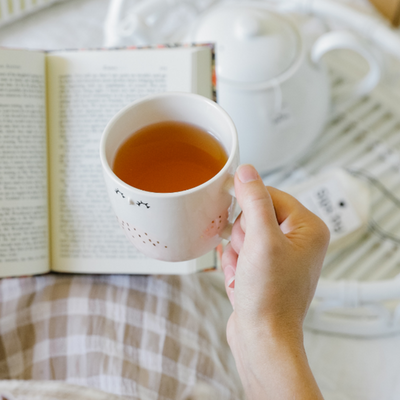
Did you know that you can start your own tea garden at home? It’s easy to grow a wide variety of healthy and aromatherapeutic herbs commonly found in your favorite herbal teas. Growing your own tea ingredients can help deepen your appreciation for tea, plus caring for the herbs that will end up in your mug can be a calming and healing wellness ritual.
Whether you want to start with a couple of small herbal tea plants for a windowsill or balcony, kitchen countertop, or to add to an outdoor garden, read on for tips to help you get started!
Sips by is a personalized tea discovery subscription. Each month, we match tea drinkers across the U.S. with delicious teas from over 150 global tea brands that we’re sure they’ll love. Members receive 4 teas chosen just for them in every box. Learn more about our tea subscription service.
Can you grow the Camellia sinensis plant?
While true tea is made from the Camellia sinensis plant, it can be a bit trickier to grow depending on where you live as it's not native to the United States. This plant grows best in Zone 8, which includes the Midwest and Southern U.S. states, but you could also start your tea plant anywhere if it’s in an indoor pot or greenhouse.
Camellia sinensis var. sinensis is mostly used for making green tea and white tea. This plant is native to China and thrives in cooler temperatures and at higher elevations. Black, oolong, and pu-erh teas are made from the Camellia sinensis var. assamica plant, which does well in tropical environments. These two varieties of the tea plant can be difficult to grow in the continental U.S, which is why we recommend starting your tea garden with herbal plants that will thrive. Though we only cover plants for making herbal tea in this post, let us know in the comments if you'd like us to follow-up with tips on growing Camellia sinensis in the next post!
How to Harvest Herbs for Making Tea
Depending on which parts of a plant are safe to consume, the leaves, buds, or flowers of certain plants can often be harvested to make your own tea and infusions. Fresh herbs or dried herbs can be used to make your own tea, though slightly different methods should be used when preparing and steeping the herbs.
How to Steep Fresh Herbal Tea
First, make sure to lightly rinse your freshly picked herbs with water to remove any bugs or dirt. Next, use a mortar and pestle, a muddler, or the bottom of a spoon, to lightly bruise the herbs in the bottom of your mug before slowly pouring boiling water over them. We recommend steeping at least 1 tablespoon of fresh herbs per cup of tea.
How to Dry Herbs for Making Tea
The best way to safely dry delicate herbs for making your own tea is to simply air dry them or use a food dehydrator. To concentrate the flavors in the leaves, you can hang dry them by tying a bundle of herbs together with twine and hanging it upside down in a dark, warm, and dry place with good air circulation. It should take about a week or more for the herbs to dry completely. Next, they are ready to be stored in an airtight container, such as glass Mason jars, until you are ready to blend or steep them. When stored correctly, dried herbs should be preserved for about one year.
Best Plants for Making Herbal Tea
Mint
Mint is a super versatile herb and is available in many different varieties. If you’d like to step outside classic mint, you can opt to grow pineapple mint, chocolate mint, apple mint, lavender mint, or Moroccan mint. Mint is easy to grow whether you opt for adding it to your existing garden, starting a container garden, or placing it in a pot near a sunny window. All that it requires is regular, light watering. The most accessible way to start growing mint is to buy already a starter plant. You don’t need to worry about pruning, either, simply cut off whatever you need for your tea or any other use, drying any excess. The mint leaves can be dried and brewed, or you can steep the fresh leaves in hot or cold water. If you’d like to mix things up, muddled fresh mint leaves can be added to this fresh mint green tea.
German Chamomile
Although German chamomile looks beautiful, with soft white leaves similar to daisies, it’s actually a resilient plant. It’s fairly easy to start from seed and grows in either full or partial sun, making it a welcome addition to pretty much any garden. Flowers can be harvested in spring before blooms fully open and used fresh or dried in teas. Chamomile also works well as part of a hair rinse, in natural perfumes or potpourris, and has a gentle, relaxing scent.
Hibiscus
In addition to being gorgeous flowers, hibiscus is edible and contains many health benefits, such as being loaded with vitamin C. Once the flowers are open, they can be dried and easily steeped for a stunning pink to red hot or iced tea. This tropical plant does well in attracting hummingbirds and butterflies and flourishes in full sun and with regular fertilizing. Those living in cooler climates will usually need to bring the plants indoors during the winter. While hibiscus makes a refreshing herbal tea, it also adds a unique flavor to desserts, such as in hibiscus shortbread or cranberry hibiscus granita.
Lemon Balm
Part of the mint family, lemon balm does well in cooler, shady parts of the garden, requiring regular watering to maintain a moist soil. In fact, it’s so easy to grow that it can spread easily throughout the garden, so you need to regularly remove the fresh leaves to prevent this, or keep your lemon balm in its own container. The lemon balm itself is sweet, with a light lemony scent, and can be used in aromatherapy, cooking, as well as in tea. Within cooking, it works great as part of a marinade for poultry or fish, or gives baking a bit of a citrus kick.
Lavender
With a gorgeous purple color and relaxing scent, lavender is a great addition to your garden as it draws in pollinators. The plants do best if planted in the spring when the soil is warm, requiring minimal watering: only once or twice a week. Harvest lavender in the morning when the oils are most concentrated, drying it or using the fresh buds to make a lavender tea. For a light tea-infused cocktail, try this recipe for a Lemon Lavender Chamomile Breeze.
Spearmint
One of the most popular types of mint, spearmint is a hardy plant that is easy to grow with regular watering. Because it spreads, spearmint is a great option for container gardening. Spearmint is a great addition to other teas, like in this Matcha Mint Julep. Frequently used in cocktails and cooking, you can also eat the spearmint leaves on their own, reaping benefits like soothing the digestive system, a high dose of antioxidants, and a natural antibacterial.
Bergamot
Wild bergamot, also known as bee balm, is another perfect plant for attracting pollinators to your garden. It adds a splash of color with beautiful red and purples and is native to North America, meaning that it is easier to grow. As long as you keep the soil moist they grow fairly easily, and plucking old blooms will encourage new flowers.
Rosemary
With pink, purple, and blue flowers, rosemary is related to the mint plant and is a fairly easy herb to grow, both indoors and out. Rosemary kept outside tends to bloom in the fall, whereas plants kept indoors can be harvested throughout the spring and summer. As a tea, rosemary is soothing to the digestive system and can help to relieve bloating, while also supporting liver health. It’s also a great culinary herb and works great in cocktails like ruby red revelation, featuring a rosemary simple syrup paired with green tea, grapefruit juice, and gin or vodka, or rosemary rooibos sidecars made with cognac.
Stevia
Although a little less traditional addition to your tea garden, stevia is a natural, calorie-free sweetener, making it a great option to help sweeten loose leaf tea, or to add to your own tea blends. Stevia plants prefer full sun and damp soil, and you can dry the leaves or use them to make your own stevia extract.
Lemongrass
Wonderfully fragrant, lemongrass adds texture to your garden with its natural grass look. Lemongrass is unique in that you can use stalks from the grocery store to start your plant: just cut a couple inches of the top of the stalks and place them in a glass of water near a sunny window. Once roots start to form you can transplant them into a pot in a sunny environment (either inside or outside) to water regularly. It’s a great herb to have on hand for use in many Asian dishes, plus it’s delicious as a Lemongrass Citrus Fizz.
Ginger
Although it differs from the other plants in that it’s a root, ginger does flower and is easier to grow than you might think for a tropical plant. The plant does well in a sheltered yet warm location and prefers moist yet not soggy soil. Ginger root makes a great tea to help with wellness in terms of soothing digestion, sore throats, and boosting your immunity, such as in the Chamomile Ginger Wellness Blend, and is a great ingredient to have on hand for cooking. You can make an easy ginger tea by simply boiling pieces of fresh ginger root in water for about ten minutes.
Echinacea
Making another great tea that helps to boost your immunity, echinacea is also known as coneflowers and blooms a beautiful purple. They’re native to America and typically grow in wooded areas or prairies, meaning that they are quite easy to grow and tolerant of different light levels and temperatures. Typically, the flowers are used to make echinacea tea and tinctures, but you can also find recipes using the roots and leaves of the plant.
Giant Hyssop
Creating a licorice-flavored tea, giant hyssop is a species of plant in the mint family that looks like lavender. It’s a hearty plant that does well in cold weather. The fragrant plant attracts butterflies and honeybees to your garden and creates a tea that is helpful to the respiratory system, especially when dealing with colds and flu. It also works well in herbal jellies and as a fresh ingredient in salads.
Sustainable Tea Shop
Explore the best sustainable tea brands with our Environmentally Friendly Tea Shop. These tea brands are dedicated to providing tea that doesn’t harm the planet, with biodegradable tea bags, plastic-free tea packaging, and fair trade tea sourcing. Some of these environmentally-conscious teas also support and donate to environmental causes, giving you tea that makes both you and Mother Nature happy. Discover your new favorite eco-friendly tea today!

Interested in trying these teas and others? Subscribers receive 4 teas chosen just for them in every box. Learn more about our tea subscription box or explore the loose leaf tea shop.
About Sips by: We’re a female-founded and led startup that makes discovering tea fun, personalized, and affordable. The Sips by Box is the only multi-brand, personalized tea subscription box. Each month, we match tea drinkers across the U.S. with delicious teas from over 150 global tea brands that we’re sure they’ll love. Based out of Austin, Texas, we are adept at savoring a hot mug even when it’s seasonally inappropriate.


